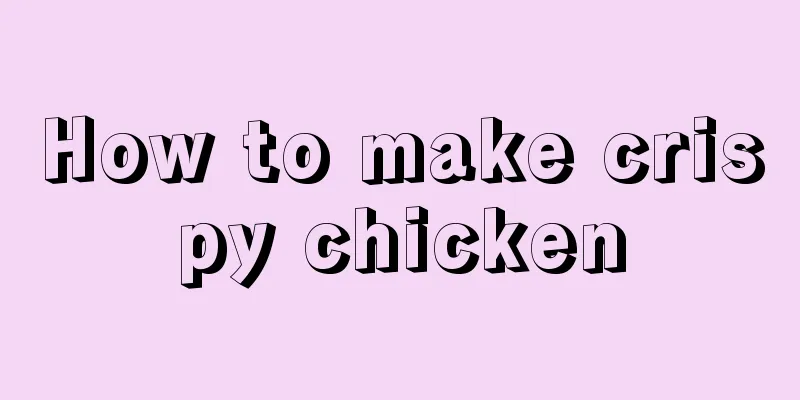What foods can't you eat if you have rhinitis?

|
Rhinitis is a chronic nasal problem caused by people not receiving timely treatment when they have nasal problems. Therefore, for patients with rhinitis, they should not only use drugs that can control the development of rhinitis to control the condition of rhinitis, but also pay close attention to their diet in life to avoid some foods that aggravate the rhinitis. In fact, there are many foods that patients with rhinitis cannot eat. The following article sorts out several foods that patients with rhinitis cannot eat. 1. What foods should you avoid when you have rhinitis? 1.1. Avoid eating cold and raw foods. Traditional Chinese medicine believes that this disease is caused by deficiency of qi in the lungs, spleen, and kidneys, coupled with external wind and cold invading the nasal cavity. Cold and raw foods (such as raw and cold fruits, cold water, cold dishes, etc.) are most likely to damage the lung and spleen yang energy and aggravate the symptoms of deficiency and cold. 1.2. Eat less milk, eggs, fish, shrimp, crab and other foods. Some people believe that foods such as milk, eggs, shrimp, and crabs are prone to cause allergic reactions, so they should be avoided when suffering from allergic diseases. Avoid beef, coffee-containing beverages, chocolate, citrus juice, corn, dairy products, eggs, oats, cherries, peanuts, salmon, strawberries, cantaloupe, tomatoes, wheat, etc. 1.3. Avoid spicy food. Such as pepper, mustard, etc., can easily irritate the respiratory mucosa. 1.4. Avoid eating foods that have been specially processed or refined, especially foods containing yellow pigment No. 5. 1.5. Avoid eating foods containing food additives such as vanillin, benzaldehyde, linalool, and monosodium hydroxyethyl ester. 2. Causes of rhinitis 2.1. Some diseases of the nasal cavity, such as deviated nasal septum, hypertrophy of the middle turbinate, nasal polyps, allergic rhinitis, nasal foreign bodies or nasal tumors. If these diseases are not treated, they will lead to rhinitis. Once patients have nasal diseases, they should go to an ENT hospital for diagnosis and treatment in time. Therefore, this is one of the causes of rhinitis. 2.2. Allergic constitution, inhalation or ingestion of allergens. This is mainly an important factor in the etiology of allergic rhinitis. The treatment for this rhinitis is to reduce the sensitivity of the nasal nerves, and drugs cannot cure it. 2.3. The cause of rhinitis is also related to the reduction of overall body resistance, such as excessive fatigue, cold and dampness, malnutrition, which lead to colds. If the cold cannot be cured after a week of treatment, it will be delayed into rhinitis. 3. Symptoms of rhinitis 3.1. Headache and dizziness When nasal congestion symptoms are severe or obvious, unilateral or bilateral headache may occur. Chronic rhinitis causes headaches mainly because the swollen nasal concha compresses the sensory nerves of the nasal cavity, which is a neuroreflex headache. 3.2 Increased nasal secretions The symptoms of rhinitis are mainly a small amount of nasal discharge, which is mostly sticky, white or slightly yellow, or a small amount of clear nasal discharge. 3.3 Nasal congestion Intermittent and alternating nasal congestion is often more obvious in the morning and evening when the temperature is low, when it is cold, or after sitting for a long time. The nasal congestion is more obvious on the lower side when sleeping on the side; the nasal congestion is more obvious when the head is in a low position. Symptoms will be alleviated or disappear when the temperature rises or after exercise. Recipes for treating rhinitis 1. Salt water Preparation method for saline nasal wash: 2 grams of table salt and 100 ml of water, boil, and add the distilled water to a small bottle. Dip a cotton ball in distilled saline and drip it into the affected nasal cavity, then gently press both sides of the nose with your fingers. 2. Garlic juice How to make garlic juice: Peel the garlic, wash it, crush it in a mortar, and filter out the garlic juice. Use a cotton ball to drip the prepared garlic juice into the nasal cavity, and gently press both sides of the nose with your fingers. 3. Vinegar fumigation Vinegar fumigation method: Pour white vinegar into a small iron bowl and burn it into a vaporized state. Inhaling the evaporated mist into the nasal cavity can help relieve the symptoms of rhinitis. 4. Xanthium sibiricum Preparation method of Xanthium sibiricum: Wash the Xanthium sibiricum, dry it, peel it, grind it, add appropriate amount of water, boil it, simmer it on low heat for 30 minutes, cool it, filter it, and put it into a small bottle. Use a cotton ball to drip the prepared Xanthium sibiricum liquid into the nasal cavity, and use your fingers to gently squeeze both sides of the nose. |
<<: Can pregnant women eat yam stewed with pork belly?
>>: What to eat after rhinitis surgery
Recommend
How to make blueberry jam in western style
Western-style blueberry jam is a food ingredient ...
How to make dry pot zucchini
Many of us want to learn how to cook, but we don’...
How to make mozzarella sandwich
Friends who like to eat pasta must not miss the r...
How to make spicy stir-fried beans
Eating is very important for a person because it ...
How to fry golden needles
There are many ways to cook enoki mushrooms. They...
How to cook stewed melon rind
Many modern people spend their days in a hurry, h...
How to make fresh cream braided bread
As the National Day holiday is approaching, you m...
What are the foods that protect your heart?
The heart is the most important organ in our body...
How to make shredded potato and egg
Many modern people spend their days in a hurry, h...
How to make braised pork with bamboo shoots
Economic development has put us under increasing ...
How to make sweet sugar beans
Some people often say that they can cook, but in ...
How to make vermicelli steamed buns
As someone who has been spoiled since childhood, ...
How to make fried duck with green pepper
Food is the most important thing for people, so a...
How to make homemade cart noodles
When we were young, our mother was around and we ...
How to make white flour steamed buns
When I get home from get off work, I should cook ...









